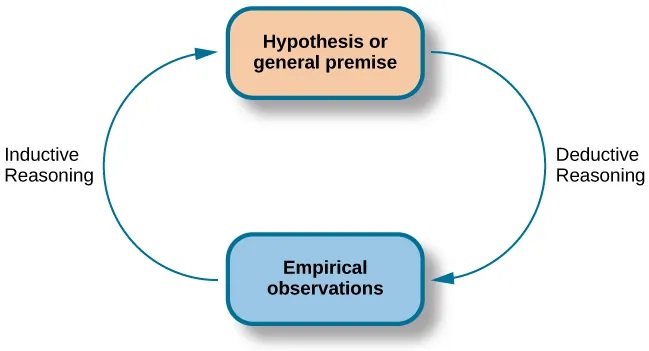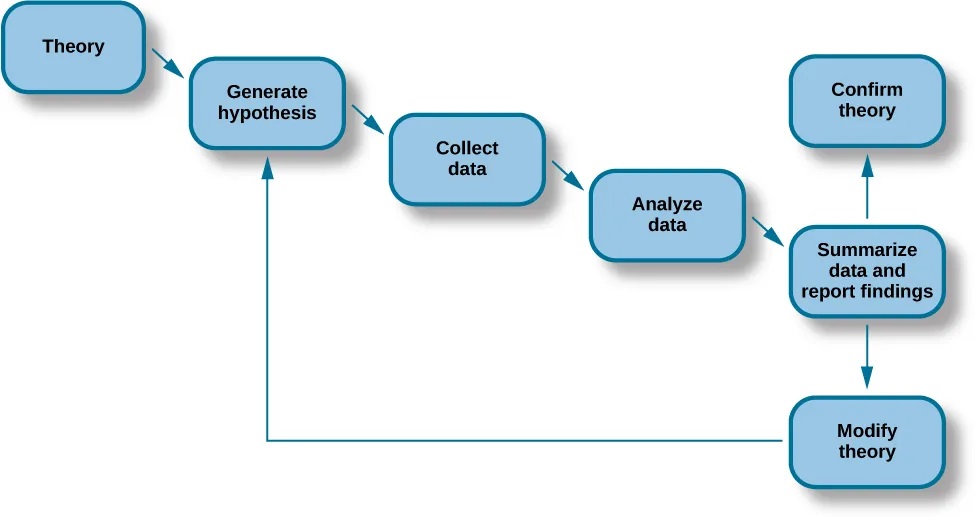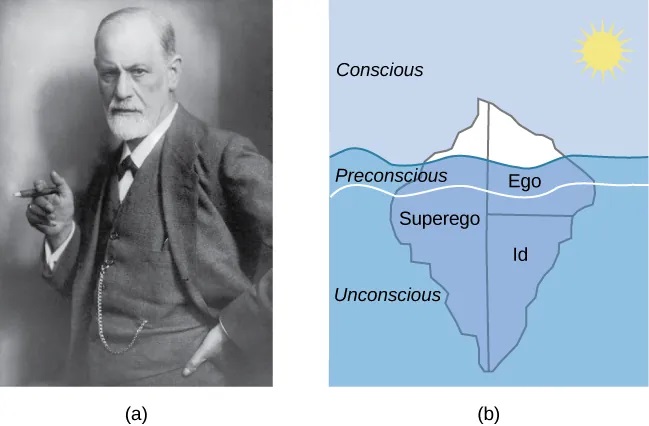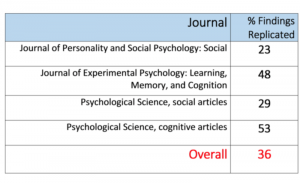Psychological Research
Learning Objectives
By the end of this section, you will be able to:
- Explain how scientific research can be used to understand behaviour
- Discuss how scientific research guides public policy
- Appreciate how scientific research can be important in making personal decisions
The Importance of Research
Scientific research is a critical tool for successfully navigating our complex world. Without it, we would be forced to rely solely on intuition, other people’s authority, and blind luck. While many of us feel confident in our abilities to decipher and interact with the world around us, history is filled with examples of how very wrong we can be when we fail to recognize the need for evidence in supporting claims. At various times in history, we would have been certain that the sun revolved around a flat earth, that the earth’s continents did not move, and that mental illness was caused by possession (Figure 3.2). It is through systematic scientific research that we divest ourselves of our preconceived notions and superstitions and gain an objective understanding of ourselves and our world.

The goal of all scientists is to better understand the world around them. Psychologists focus their attention on understanding behaviour, as well as the cognitive (mental) and physiological (bodily) processes that underlie behaviour. In contrast to other methods that people use to understand the behaviour of others, such as intuition and personal experience, the hallmark of scientific research is that there is evidence to support a claim. Scientific knowledge is empirical: It is grounded in objective, tangible evidence that can be observed time and time again, regardless of who is observing.
While behaviour is observable, the mind is not. If someone is crying, we can see behaviour. However, the reason for the behaviour is more difficult to determine. Is the person crying due to being sad, in pain, or happy? Sometimes we can learn the reason for someone’s behaviour by simply asking a question, like “Why are you crying?” However, there are situations in which an individual is either uncomfortable or unwilling to answer the question honestly, or is incapable of answering. For example, infants would not be able to explain why they are crying. In such circumstances, the psychologist must be creative in finding ways to better understand behaviour. This chapter explores how scientific knowledge is generated, and how important that knowledge is in forming decisions in our personal lives and in the public domain.
Use of Research Information
Trying to determine which theories are and are not accepted by the scientific community can be difficult, especially in an area of research as broad as psychology. More than ever before, we have an incredible amount of information at our fingertips, and a simple internet search on any given research topic might result in a number of contradictory studies. In these cases, we are witnessing the scientific community going through the process of reaching a consensus, and it could be quite sometime before a consensus emerges. For example, the explosion in our use of technology has led researchers to question whether this ultimately helps or hinders us. The use and implementation of technology in educational settings has become widespread over the last few decades (and certainly increased with the COVID-19 pandemic). Researchers are coming to different conclusions regarding the use of technology. To illustrate this point, a study investigating a smartphone app targeting surgery residents (graduate students in surgery training) found that the use of this app can increase student engagement and raise test scores (Shaw & Tan, 2015). Conversely, another study found that the use of technology in undergraduate student populations had negative impacts on sleep, communication, and time management skills (Massimini & Peterson, 2009). Until sufficient amounts of research have been conducted, there will be no clear consensus on the effects that technology has on a student’s acquisition of knowledge, study skills, and mental health.
Try reading a few research articles about a topic that you are interested in. Do the articles have similar or different conclusions?
Some basic ideas for topics (you may wish to be more specific with your questions):
- How does the use of technology impact student learning?
- How does sleep impact student engagement?
- How does caffeine effect your attention and mood?
The SAIT Library and Google Scholar are great places to start looking for published research.
In the meantime, we should strive to think critically about the information we encounter by exercising a degree of healthy skepticism. When someone makes a claim, we should examine the claim from a number of different perspectives: what is the expertise of the person making the claim, what might they gain if the claim is valid, does the claim seem justified given the evidence, and what do other researchers think of the claim? This is especially important when we consider how much information in advertising campaigns and on the internet claims to be based on “scientific evidence” when in actuality it is a belief or perspective of just a few individuals trying to sell a product or draw attention to their perspectives.
We should be informed consumers of the information made available to us because decisions based on this information have significant consequences. One such consequence can be seen in politics and public policy. Imagine that you have been elected as the governor of your state. One of your responsibilities is to manage the state budget and determine how to best spend your constituents’ tax dollars. As the new governor, you need to decide whether to continue funding early intervention programs. These programs are designed to help children who come from low-income backgrounds, have special needs, or face other disadvantages. These programs may involve providing a wide variety of services to maximize the children’s development and position them for optimal levels of success in school and later in life (Blann, 2005). While such programs sound appealing, you would want to be sure that they also proved effective before investing additional money in these programs. Fortunately, psychologists and other scientists have conducted vast amounts of research on such programs and, in general, the programs are found to be effective (Neil & Christensen, 2009; Peters-Scheffer, Didden, Korzilius, & Sturmey, 2011). While not all programs are equally effective, and the short-term effects of many such programs are more pronounced, there is reason to believe that many of these programs produce long-term benefits for participants (Barnett, 2011). If you are committed to being a good steward of taxpayer money, you would want to look at the research. Which programs are most effective? What characteristics of these programs make them effective? Which programs promote the best outcomes? After examining the research, you would be best equipped to make decisions about which programs to fund.
Ultimately, it is not just politicians who can benefit from using research in guiding their decisions. We all might look to research from time to time when making decisions in our lives. Imagine you just found out that a close friend has breast cancer or that one of your young relatives has recently been diagnosed with autism. In either case, you want to know which treatment options are most successful with the fewest side effects. How would you find that out? You would probably talk with your doctor and personally review the research that has been done on various treatment options—always with a critical eye to ensure that you are as informed as possible.
In the end, research is what makes the difference between facts and opinions. Facts are observable realities, and opinions are personal judgments, conclusions, or attitudes that may or may not be accurate. In the scientific community, facts can be established only using evidence collected through empirical research.
Research is not always perfect (it usually isn’t) but it does give us an idea of how things work and how they are related in the world. Sometimes, however, you will find bad science – research that was poorly done, sometimes purposefully, which comes to unfounded conclusions. Many examples of this exist and published research can be retracted if an investigation finds that the research had significant shortcomings. The best way to critically examine published research is by carefully reading the methodology used by the scientists and evaluating the claims that go along with it.
You can search through retracted research reports and read some examples on the Retraction Watch website.
NOTABLE RESEARCHERS
Psychological research has a long history involving important figures from diverse backgrounds. While the introductory chapter discussed several researchers who made significant contributions to the discipline, there are many more individuals who deserve attention in considering how psychology has advanced as a science through their work (Figure 3.3). For instance, Margaret Floy Washburn (1871–1939) was the first woman to earn a PhD in psychology. Her research focused on animal behaviour and cognition (Margaret Floy Washburn, PhD, n.d.). Mary Whiton Calkins (1863–1930) was a preeminent first-generation American psychologist who opposed the behaviourist movement, conducted significant research into memory, and established one of the earliest experimental psychology labs in the United States (Mary Whiton Calkins, n.d.).
Francis Sumner (1895–1954) was the first African American to receive a PhD in psychology in 1920. His dissertation focused on issues related to psychoanalysis. Sumner also had research interests in racial bias and educational justice. Sumner was one of the founders of Howard University’s department of psychology, and because of his accomplishments, he is sometimes referred to as the “Father of Black Psychology.” Thirteen years later, Inez Beverly Prosser (1895–1934) became the first African American woman to receive a PhD in psychology. Prosser’s research highlighted issues related to education in segregated versus integrated schools, and ultimately, her work was very influential in the hallmark Brown v. Board of Education Supreme Court ruling that segregation of public schools was unconstitutional (Ethnicity and Health in America Series: Featured Psychologists, n.d.).

Notable Canadian Researchers
Donald O. Hebb
Often considered the “father of neuropsychology”, Hebb was a Canadian Psychologist influential in both psychology and neuroscience. Hebb’s major contribution was a theory published in 1949, which suggested that frequently used neural pathways tend to become stronger and faster; this “Hebbian theory” provided important groundwork for understanding learning and memory (Ferguson, 2021)
Albert Bandura
Bandura is an Alberta-born Psychologist who has received numerous awards and recognition for his work on observational learning and self-efficacy. Bandura’s best known theory is known as social cognitive theory, which states that a “person’s environment, cognition and behaviour all interact to determine how that person functions” (Nolen, 2020) . Bandura is one of the most cited psychologists of all time, along with Sigmund Freud, B.F. Skinner, and Jean Piaget (American Psychological Association, 2002).
Vimla L. Patel
A Fijian-born Canadian psychologist specializing in medical cognition and the psychology of human computer interactions (Wikipedia contributors, 2020). Patel’s research has examined decision making and problem-solving in a medical context, often with a focus on physicians who are multitasking. Patel has also conducted research examining the use of technology in medical contexts.
Jeffrey Ansloos
A Registered Psychologist, and an Assistant Professor in Indigenous Health and Social Policy.
Dr. Ansloos’ research focuses on Indigenous health, social policy, and in particular suicide and suicide prevention. He also examines community-based and systems-level change processes needed to advance social and health equity within Canada, with a particular focus on Indigenous rights. Dr. Ansloos also researches the role of emergent technologies at the intersection of community mobilization and social change.
Dr. Ansloos is Nehiyaw (Cree) and English, and is a member of Fisher River Cree Nation (Ochekwi-Sipi; Treaty 5). He grew up in Winnipeg, Manitoba (Treaty 1), and currently resides in Toronto (Tkaranto) (Jeffrey Ansloos, PhD).
Although the establishment of psychology’s scientific roots occurred first in Europe and the United States, it did not take much time until researchers from around the world began to establish their own laboratories and research programs. For example, some of the first experimental psychology laboratories in South America were founded by Horatio Piñero (1869–1919) at two institutions in Buenos Aires, Argentina (Godoy & Brussino, 2010). In India, Gunamudian David Boaz (1908–1965) and Narendra Nath Sen Gupta (1889–1944) established the first independent departments of psychology at the University of Madras and the University of Calcutta, respectively. These developments provided an opportunity for Indian researchers to make important contributions to the field (Gunamudian David Boaz, n.d.; Narendra Nath Sen Gupta, n.d.).
When the American Psychological Association (APA) was first founded in 1892, all of the members were white males (Women and Minorities in Psychology, n.d.). However, by 1905, Mary Whiton Calkins was elected as the first female president of the APA, and by 1946, nearly one-quarter of American psychologists were female. Psychology became a popular degree option for students enrolled in the nation’s historically black higher education institutions, increasing the number of black Americans who went on to become psychologists. Given demographic shifts occurring in the United States and increased access to higher educational opportunities among historically underrepresented populations, there is reason to hope that the diversity of the field will increasingly match the larger population and that the research contributions made by the psychologists of the future will better serve people of all backgrounds (Women and Minorities in Psychology, n.d.).
The Process of Scientific Research
Scientific knowledge is advanced through a process known as the scientific method. Basically, ideas (in the form of theories and hypotheses) are tested against the real world (in the form of empirical observations), and those empirical observations lead to more ideas that are tested against the real world, and so on. In this sense, the scientific process is circular. The types of reasoning within the circle are called deductive and inductive. In deductive reasoning, ideas are tested in the real world; in inductive reasoning, real-world observations lead to new ideas (Figure 3.4). These processes are inseparable, like inhaling and exhaling, but different research approaches place different emphasis on the deductive and inductive aspects.

In the scientific context, deductive reasoning begins with a generalization—one hypothesis—that is then used to reach logical conclusions about the real world. If the hypothesis is correct, then the logical conclusions reached through deductive reasoning should also be correct. A deductive reasoning argument might go something like this: All living things require energy to survive (this would be your hypothesis). Ducks are living things. Therefore, ducks require energy to survive (logical conclusion). In this example, the hypothesis is correct; therefore, the conclusion is correct as well. Sometimes, however, an incorrect hypothesis may lead to a logical but incorrect conclusion. Consider this argument: all ducks are born with the ability to see. Quackers is a duck. Therefore, Quackers was born with the ability to see. Scientists use deductive reasoning to empirically test their hypotheses. Returning to the example of the ducks, researchers might design a study to test the hypothesis that if all living things require energy to survive, then ducks will be found to require energy to survive.
Deductive reasoning starts with a generalization that is tested against real-world observations; however, inductive reasoning moves in the opposite direction. Inductive reasoning uses empirical observations to construct broad generalizations. Unlike deductive reasoning, conclusions drawn from inductive reasoning may or may not be correct, regardless of the observations on which they are based. For instance, you may notice that your favorite fruits—apples, bananas, and oranges—all grow on trees; therefore, you assume that all fruit must grow on trees. This would be an example of inductive reasoning, and, clearly, the existence of strawberries, blueberries, and kiwi demonstrate that this generalization is not correct despite it being based on a number of direct observations. Scientists use inductive reasoning to formulate theories, which in turn generate hypotheses that are tested with deductive reasoning. In the end, science involves both deductive and inductive processes.
For example, case studies, which you will read about in the next section, are heavily weighted on the side of empirical observations. Thus, case studies are closely associated with inductive processes as researchers gather massive amounts of observations and seek interesting patterns (new ideas) in the data. Experimental research, on the other hand, puts great emphasis on deductive reasoning.
We’ve stated that theories and hypotheses are ideas, but what sort of ideas are they, exactly? A theory is a well-developed set of ideas that propose an explanation for observed phenomena. Theories are repeatedly checked against the world, but they tend to be too complex to be tested all at once; instead, researchers create hypotheses to test specific aspects of a theory.
A hypothesis is a testable prediction about how the world will behave if our idea is correct, and it is often worded as an if-then statement (e.g., if I study all night, I will get a passing grade on the test). The hypothesis is extremely important because it bridges the gap between the realm of ideas and the real world. As specific hypotheses are tested, theories are modified and refined to reflect and incorporate the result of these tests Figure 3.5.

To see how this process works, let’s consider a specific theory and a hypothesis that might be generated from that theory. As you’ll learn in a later chapter, the James-Lange theory of emotion asserts that emotional experience relies on the physiological arousal associated with the emotional state. If you walked out of your home and discovered a very aggressive snake waiting on your doorstep, your heart would begin to race and your stomach churn. According to the James-Lange theory, these physiological changes would result in your feeling of fear. A hypothesis that could be derived from this theory might be that a person who is unaware of the physiological arousal will not feel fear.
A scientific hypothesis is also falsifiable or capable of being shown to be incorrect. Recall from the introductory chapter that Sigmund Freud had lots of interesting ideas to explain various human behaviours (Figure 3.6). However, a major criticism of Freud’s theories is that many of his ideas are not falsifiable; for example, it is impossible to imagine empirical observations that would disprove the existence of the id, the ego, and the superego—the three elements of personality described in Freud’s theories. Despite this, Freud’s theories are widely taught in introductory psychology texts because of their historical significance for personality psychology and psychotherapy, and these remain the root of all modern forms of therapy.

In contrast, the James-Lange theory does generate falsifiable hypotheses, such as the one described above. Some individuals who suffer significant injuries to their spinal columns are unable to feel the bodily changes that often accompany emotional experiences. Therefore, we could test the hypothesis by determining how emotional experiences differ between individuals who have the ability to detect these changes in their physiological arousal and those who do not. In fact, this research has been conducted and while the emotional experiences of people deprived of an awareness of their physiological arousal may be less intense, they still experience emotion (Chwalisz, Diener, & Gallagher, 1988).
Scientific research’s dependence on falsifiability allows for great confidence in the information that it produces. Typically, by the time information is accepted by the scientific community, it has been tested repeatedly.
The Replication Crisis in Psychology

Recently, there has been growing concern as psychological research fails to replicate. To give you an idea of the extent of non-replicability of psychology findings, Table 3.1 shows data reported in 2015 by the Open Science Collaboration project, led by University of Virginia psychologist Brian Nosek (Open Science Collaboration, 2015). Because these findings were reported in the prestigious journal, Science, they received widespread attention from the media. Here are the percentages of research that replicated—selected from several highly prestigious journals:
Clearly, there is a very large problem when only about 1/3 of the psychological studies in premier journals replicate! It appears that this problem is particularly pronounced for social psychology but even the 53% replication level of cognitive psychology is cause for concern.
The situation in psychology has grown so worrisome that the Nobel Prize-winning psychologist Daniel Kahneman called on social psychologists to clean up their act (Kahneman, 2012). The Nobel laureate spoke bluntly of doubts about the integrity of psychology research, calling the current situation in the field a “mess.” His missive was pointed primarily at researchers who study social “priming,” but in light of the non-replication results that have since come out, it might be more aptly directed at the behavioural sciences in general.

